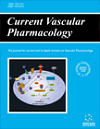-
oa Editorial [Hot Topic: The Evolution of Cell Therapy Towards Enhancing Vascular Regeneration in the Clinic (Guest Editors: Drew Kuraitis and Erik J. Suuronen)]
- Source: Current Vascular Pharmacology, Volume 10, Issue 3, May 2012, p. 269 - 270
-
- 01 May 2012
- Previous Article
- Table of Contents
- Next Article
Abstract
Shortly after its birth, stem cell therapy became a powerhouse in health research and continues to hold great expectations for reversing or treating various diseases. Independent clinical trials showed improvements in patients with ischemic myocardium, peripheral arterial disease or stroke after transplantation with marrow- or peripheral blood-derived angiogenic adult cells, arguably some of the safest stem cells for clinical application [1-4]. Despite these promising results, larger randomized trials are needed to confirm the findings, and improvements in the magnitude of the revascularization response to treatment are still desired. The results seen in the clinic are in contrast to the much more encouraging results that were initially seen in animal models. Now, after these initial bench-to-bedside investigations, researchers are making a return to the bench in order to better assess and improve upon the methods of cell therapy. It was initially believed that transplanted stem cells would constitute newly developed vessels and that this was the mechanism by which neovascularization occurred. Later studies instead demonstrated that the main source of neovascularization was a paracrine signaling cascade, which is augmented and/or amplified by transplanted cells, and that the process of vascular regeneration is then largely maintained by the host's own endogenous cell populations [5, 6]. Performing similar in vivo work and “transplanting” acellular conditioned medium and observing similar functional effects further supports this mechanism [7, 8]. Essentially, transplantable cells act as pharmacological production factories, responding to their environment and producing desired cytokines to better aid the regenerative process. Based on this, stem cells may have the potential to reduce, complement, or replace the requirement for pharmacological treatment in vascular disease patients. However, several limitations exist that are restricting the success achieved by the application of cell therapy for vascular disease in the clinic [9, 10]. Firstly, transplanted cells exhibit poor persistence and viability. In theory, overcoming this hurdle would prolong the therapeutic production of “natural drugs”. Secondly, patients at risk, namely diabetics and those with ischemic heart disease, have endogenous stem cell populations that are greatly limited in their therapeutic potential. Reversing the dysfunction of cells from disease-state patients could improve cell therapy two-fold: autologous cells could be harvested and transplanted, and endogenous cells could be activated or stimulated to be more therapeutically effective in situ.....


